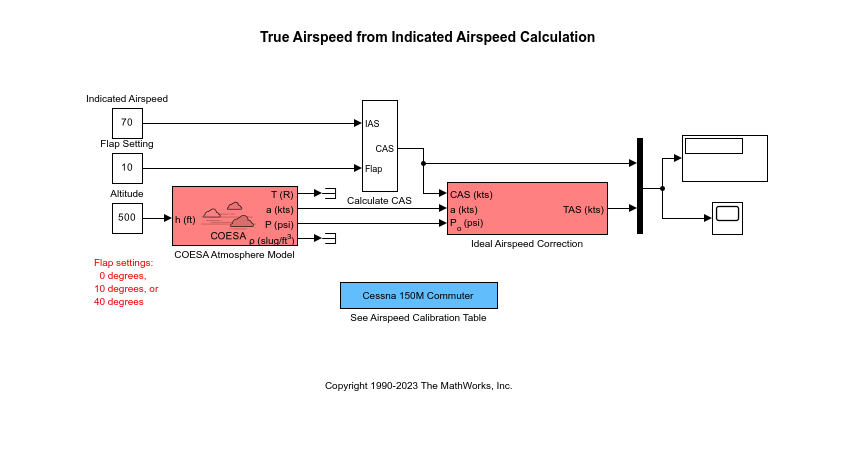True Airspeed from Indicated Airspeed Calculation
This model shows how to compute true airspeed from indicated airspeed using the Ideal Airspeed Correction block. The Aerospace Blockset™ blocks are indicated in red.
open_system('aeroblk_calibrated'); snapshotModel('aeroblk_calibrated');

Calculating True Airspeed
True airspeed (TAS) is the airspeed that we would read ideally (and the airspeed value easily calculated within a simulation). However there are errors introduced through the pitot-static airspeed indicators used to determine airspeed. These measurement errors are density error, compressibility error and calibration error. Removing these errors from indicated airspeed (IAS) will result in true airspeed.
Correcting Indicated Airspeed for Calibration Error
An airspeed indicator has static vent(s) to maintain a pressure equal to atmospheric pressure inside the instrument. Position and placement of the static vent along with angle of attack and velocity of the aircraft will determine the pressure inside the airspeed indicator and thus the amount of calibration error of the airspeed indicator. Needless to say, calibration error is specific to a given aircraft design. A calibration table is usually given in the pilot operating handbook (POH) or in other aircraft specifications. Using this calibration table, the calibrated airspeed (CAS) is determined from indicated airspeed by removing the calibration error of the airspeed indicator. Indicated airspeed is displayed in the cockpit instrumentation.
This example is using the airspeed calibration table for the Cessna 150M from "Pilot's Operating Handbook, Cessna 1976 150 Commuter, Cessna Model 150M", Cessna Aircraft Company, Wichita, Kansas, USA, 1976.
Correcting Calibrated Airspeed for Compressibility and Density Errors
The Ideal Airspeed Correction block is used to correct calibrated airspeed to true airspeed by removing the compressibility error and the density error.
Compressibility Error
Air has a limited ability to resist compression. This ability is reduced by an increase in altitude, an increase in speed, or a restricted volume. Within the airspeed indicator, there is a certain amount of trapped air. When flying at high altitudes and higher airspeeds, calibrated airspeed is always higher than equivalent airspeed (EAS). Equivalent airspeed is calibrated airspeed with compressibility effects of air which affect the airspeed indicator removed.
Density Error
An airspeed indicator reads lower than true airspeed at higher altitudes. This is due to lower air density at altitude. When the difference or error in air density at altitude from air density on a standard day at sea level is applied to true airspeed, it results in equivalent airspeed. True airspeed is equivalent airspeed with the changes in atmospheric density which affect the airspeed indicator removed.
Simulate Model to Display Airspeeds
You can see the true airspeed based on the example calibration tables modeled in the Calculate CAS block. After simulating the model, true airspeed is displayed with calibrated airspeed in the scope and the display block.
See Also
Ideal Airspeed Correction | COESA Atmosphere Model